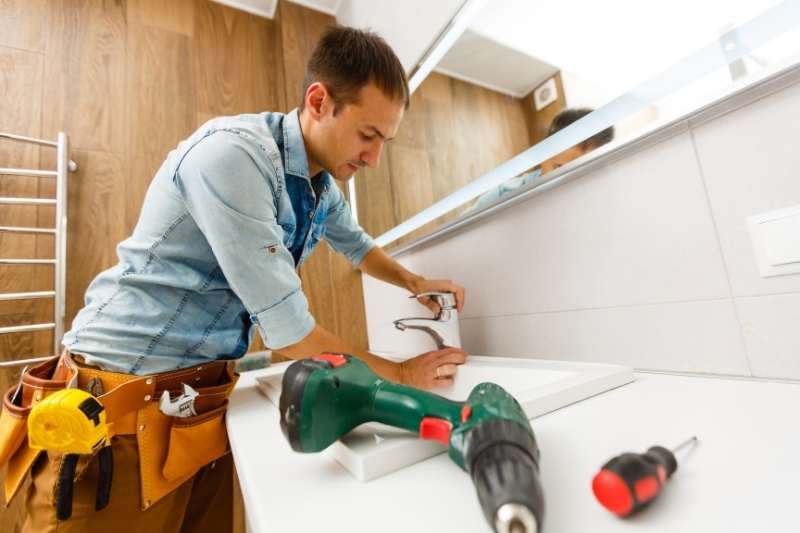
Spring house maintenance is essential for keeping your home functional and healthy. It's an excellent way to eliminate clutter and get rid off unwanted items. Additionally, you can make minor repairs to the house, like fixing a leaky faucet, or replacing a cracked window. You'll be able complete these tasks by following a checklist.
Before the summer months, you should check your programmable thermostat. This will ensure you are not wasting electricity. Clean your filters regularly. This will prevent you from paying high-priced air conditioner bills. You'll save more energy if your dryer and air conditioner are efficient.
You should also check your fireplace. Winter can cause chimney damage, especially if the fireplace is in a wooded environment. If you're interested in saving money, you may want to consider installing a solar powered system. You will be able to reduce your electricity bill while keeping your home cool in warmer months.

A key spring maintenance task is to clean your gutters. Keeping them clear can prevent clogs that can lead to water damage. To help you do this, hire a plumber or a company that specializes in cleaning drainage.
A spring maintenance task that must be done is to remove all paint from exterior trim or siding. This can be time-consuming, but it will make your house look better over the long-term.
You can also hire a professional to clean your gutters. They can also remove any dirt and paint that has accumulated over the winter.
Checking the roof for signs of damage is another item on the spring house maintenance checklist. This is an important part of the house that many homeowners neglect. Even if you've already made a few repairs, you should still perform a full inspection. Some of the most common roof repair jobs include repairing or replacing shingles, adjusting ventilation or vent covers, and inspecting the flashing and soffit.

Aside from checking your roof, you should also perform other spring house maintenance tasks such as checking your gutters and drains. These are vital components of your home, and can lead to serious issues if they aren’t properly maintained.
You'll also want to consider getting your home insured. You can protect yourself from theft or other damage by having your home insured. After you have assessed your coverage needs, it is possible to modify your policy to fit your home.
Last but not least, inspect your fence. Most burglars say that a well-built fence is an effective deterrent. You should inspect for cracks, holes, and rot. If you notice any of these things, you should fix them immediately. Fences can be a great visual for your backyard in spring.
FAQ
How long does a handyman take?
To become a skilled handyman, it takes many years of hard labor. It begins with helping friends and families and grows to become a full-time profession.
As you learn, you'll be able to master all of the necessary skills.
Who will complete my handyman work?
A professional handyman is the best choice if you need someone to do a single job like fixing a faucet or replacing a light fixture. Handyman services might be an option for you if you have several jobs to complete, such a roof repair or new floor tile installation.
Handyman Services can provide ongoing support for those in need, including maintenance.
How often should I call a handyman?
It depends on your project. A handyman may be all you need for a small job, such as replacing a light bulb. You might have to call several handymen if the job involves a lot more remodeling.
What's the time taken by a handyman for a project to be completed?
It depends on the size of the project. The size of the project will determine how long it takes. Larger projects may take more time. Regardless of the size, though, a handyman will typically finish within one week.
What does the average handyman charge an hour?
A handyman can charge between $50-$75 an hour. They have been doing this for many years. On average, they work for around 10 hours. They are well-known and do not need advertising.
They tend to specialize and develop customer relationships over time.
Their key difference from other contractors is their quickness, reliability, and affordability.
Most people have at least two or three of these guys that they can trust enough to call for help when they need it.
Some people are so talented that they own their own business.
When is the right moment to hire a handyman
There is no "right time" to hire a handyman. You should get started as soon you can. Of course, you can wait until after the holidays to save some money. You could also pick up the telephone and call various handymen.
Which is easier, contracting or being handyman?
Being a handyman requires fewer resources than contracting, as you only need yourself and tools. However, you must be able to manage your own workload and schedule, while contractors typically rely on subcontractors to do most of the work.
Statistics
- More than 20% of homes in America have outdoor living spaces, including decks and patios. (mrhandyman.com)
- Our handyman services for seniors are provided by professional senior helpers who have been serving the community for over 20 years with 98% customer satisfaction. (cantatahomeservices.org)
- Another estimate was that the market in the United States was $126 billion and was increasing by about 4% annually. (en.wikipedia.org)
- A franchise was approximately $110,000 with a franchise fee of $14,900, according to a spokesperson for a national handyman franchise. (en.wikipedia.org)
- According to the U.S. Bureau of Labor Statistics, in May 2020, there are 1,357,630 handymen employed in the U.S.. (angi.com)
External Links
How To
How to Install A Receptacle Box
It is important to follow the recommendations of your local inspector when installing any type electric outlet. This includes making sure that the wiring is correctly installed and that there aren't any fire hazards or water damage.
For installation, most boxes come prewired with four wires coming directly from the breaker panels. The box's two black wires are connected to the first screw. The red and white wires connect to the second screw. When connecting wires together, you must ensure that the wire nuts and wire wraps are not used. It is likely that you will have problems getting the wires into place after tightening them down. They should be loose enough for them to move but not too tight that they pull out of their holes.
You might want to add a receptacle to an existing box. You'll need to take off the top of your existing metal box, and then add a cover plate. After the cover plate has been attached and the hole for the new receptacle is created, it is time to connect all the wires to this new receptacle.
It is possible to replace existing light switches in your house with modern ones without the need for a licensed electrician. The first step is to take the old switch out of its mounting spot. You should then disconnect all wires from the switch. These wires are the ones that supply power to the switch as well as the ones that supply electricity for the lights in the area where it is located. Once you have disconnected all of it, you can begin the replacement process.
After you remove the old switch, measure how far the wall studs are from your new switch and mark them using a permanent marker. Once you've done this, you need to decide if the switch should be placed high above or low to the floor. You will need to drill holes for the mounting bracket depending on how high the switch is to be mounted. Or you can attach it directly to the wall with drywall anchors.
Once you have the measurements taken and the locations marked, it is time to start the project. With the help of a friend or family member, you can start removing the drywall surrounding the area where the switch will be installed. For cable safety, make sure you leave 8 inches between each of the studs. Next, you will need to install the new switch using the appropriate mounting brackets. Attach the cables to your switch and then secure it onto the mounting plates. Once the switch is fully installed, you'll need to turn back the power and test it for proper operation.